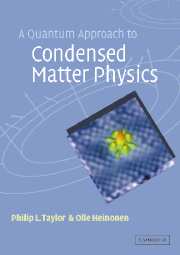Book contents
- Frontmatter
- Contents
- Preface
- Chapter 1 Semiclassical introduction
- Chapter 2 Second quantization and the electron gas
- Chapter 3 Boson systems
- Chapter 4 One-electron theory
- Chapter 5 Density functional theory
- Chapter 6 Electron–phonon interactions
- Chapter 7 Superconductivity
- Chapter 8 Semiclassical theory of conductivity in metals
- Chapter 9 Mesoscopic physics
- Chapter 10 The quantum Hall effect
- Chapter 11 The Kondo effect and heavy fermions
- Bibliography
- Index
Chapter 10 - The quantum Hall effect
Published online by Cambridge University Press: 05 June 2012
- Frontmatter
- Contents
- Preface
- Chapter 1 Semiclassical introduction
- Chapter 2 Second quantization and the electron gas
- Chapter 3 Boson systems
- Chapter 4 One-electron theory
- Chapter 5 Density functional theory
- Chapter 6 Electron–phonon interactions
- Chapter 7 Superconductivity
- Chapter 8 Semiclassical theory of conductivity in metals
- Chapter 9 Mesoscopic physics
- Chapter 10 The quantum Hall effect
- Chapter 11 The Kondo effect and heavy fermions
- Bibliography
- Index
Summary
Quantized resistance and dissipationless transport
The Hall effect has long been a standard tool used to characterize conductors and semiconductors. When a current is flowing in a system along one direction, which we here take to be the y-axis, and a magnetic field H is applied in a direction perpendicular to the current, e.g., along the z-axis, there will be an induced electrostatic field along the x-axis. The magnitude of the field E is such that it precisely cancels the Lorentz force on the charges that make up the current. For free electrons, an elementary calculation of the type indicated in Section 1.8 yields the Hall resistivity ρH = −H/ρ0ec, and apparently provides a measure of the charge density of the electrons. For Bloch electrons, as we saw in Section 8.3, the picture is more complicated, but ρH is still predicted to be a smoothly varying function of H and of the carrier density. In some circumstances, however, the semiclassical treatment of transport turns out to be inadequate, as some remarkable new effects appear.
In a two-dimensional system subjected to strong magnetic fields at low temperatures, the response is dramatically different in two respects. First, the Hall resistivity stops varying continuously, and becomes intermittently stuck at quantized values ρH = −h/je2 for a finite range of control parameter, e.g., external magnetic field or electron density. In the integer quantum Hall effect, j is an integer, j = 1, 2, …, and in the fractional quantum Hall effect, j is a rational number j = q/p, with p and q relative primes and p odd.
- Type
- Chapter
- Information
- A Quantum Approach to Condensed Matter Physics , pp. 342 - 382Publisher: Cambridge University PressPrint publication year: 2002



